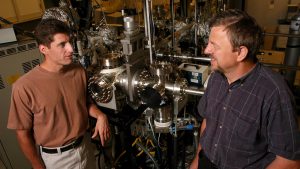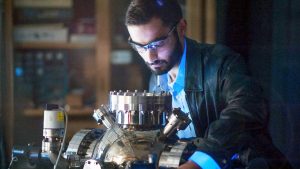Fresh Material

In the past eighteen months, no fewer than six startups have sprung from groundbreaking discoveries in NC State’s Department of Materials Science and Engineering (MSE). Those six companies join more than a dozen other big names founded on the department’s research — including Kyma, HexaTech, Nitronex, and multinational lighting and electronics giant Cree.
That sustained success over time is testament both to the strong infrastructure the university has built for technology transfer and to a philosophy of application that is intrinsic to Materials Science and Engineering at NC State.
“We’re the only department with both ‘science’ and ‘engineering’ in our name,” says Justin Schwartz, Kobe Steel Distinguished Professor and department head since 2009. “We’ve always been committed to that continuum from idea to execution. Our research doesn’t stop with publication; it’s also about taking the next step, realizing the idea and putting products in people’s hands.”
Here are the six MSE startups taking that next step:
Third Floor Materials
Infrared imaging — which allows us to “see” the heat emitted by objects in the world — currently requires cryogenic cooling to work. But materials science and engineering researcher Jon-Paul Maria is pioneering new, midwave infrared technology that requires no liquid refrigerants, opening the door for imaging devices that are less bulky, less expensive and require less power.

In 2015, a $75,000 grant from the Chancellor’s Innovation Fund helped Maria design, build and begin testing a prototype of the technology. Since then, his three-person startup, Third Floor Materials, has generated almost $3.5 million in follow-up funding for NC State. The company has also received support from NASA and DARPA, whose interests span the range of potential applications for Maria’s technology: from weather forecasting and space exploration to improving the situational awareness of troops on the battlefield.
Custom Nano
Gold nanorods have long held promise for a host of applications — from biomedical imaging to potential cancer treatment — because of how they absorb and scatter light. But the quality of gold nanorods already on the market has tended to be highly variable, making it harder for researchers to unlock their potential.
Materials science and engineering Professor Joseph Tracy has developed new techniques that enable the creation of more consistent batches of gold nanorods — including a customizable silica coating that protects their shape and reduces their toxicity in the body. Tracy is now the technical advisor to Custom Nano, an NC State startup that has licensed his technology and aims to supply gold nanorods that meet the needs of researchers and private-sector companies.
Atomix LLX
Spun off from Linyou Cao’s lab, Atomix LLX is a startup doing business as 2D Layer. The company is dedicated to manufacturing large-scale, high-quality, atomically-thin two-dimensional transition metal dichalcogenide materials for both research and industrial purposes. These materials hold promise for the next generation of semiconductors, as they offer an unprecedented pairing of high performance and flexibility. They could ultimately see use in flexible integrated circuits, flexible LEDs or displays, and smart sensors.
Eagle Power Technologies Inc.

MSE department head Justin Schwartz has teamed up with Aaron Frahm and U.S. Air Force Major General (retired) David J. Eichhorn to potentially bring to market a number of NC State inventions, including those related to superconducting magnet design and other transformational materials discovered and developed within MSE.
Eichhorn’s guiding interest is the creation of high-speed superconducting motors for commercial or military jets — pursuing a dramatic increase in specific power while reducing maintenance demands. Eagle Power currently holds seven patents ranging from supercomputing to superconducting and has already garnered significant private investment.
Q-Carbon LLC
In late 2015, Jagdish Narayan, the John C. Fan Distinguished Chair Professor of Materials Science and Engineering at NC State, announced that he and his graduate student Anagh Bhaumik had discovered a new solid phase of carbon, distinct from graphite or diamond, which they dubbed “Q-carbon.”
Q-carbon may be harder than diamond, is magnetic, electrically conductive, and glows when exposed to low levels of energy. That extraordinary combination of properties could be game-changing for drug delivery, display technologies, the creation of high-temperature switches and power electronics, or industrial processes like deep-sea drilling. With investor funding, Narayan has now teamed up with the founders of Eagle Power to launch Q-Carbon LLC, a startup that will explore and commercialize the potential applications of Narayan’s research.
Lupine Materials and Technologies
Superconducting magnets are essential to MRI machines, mass spectrometers and particle accelerators such as the world-famous Large Hadron Collider. They are also susceptible to sudden “quenches,” when the magnet loses its ability to conduct electricity without resistance, generating heat that shuts the system down for several hours — if not longer.

Detecting and mitigating these quenches is one of the focuses of Lupine Materials and Technologies, a startup Schwartz has founded with two MSE postdoctoral researchers, Golsa Naderi and Ali Moballegh. By integrating optical fibers and thermally conductive insulation into magnet design, they hope to reduce quench behavior and enable a new generation of superconductive technologies. The company has already received the support of the Department of Energy’s Office of High-Energy Physics through a Small Business Technology Transfer grant.
- Categories:


